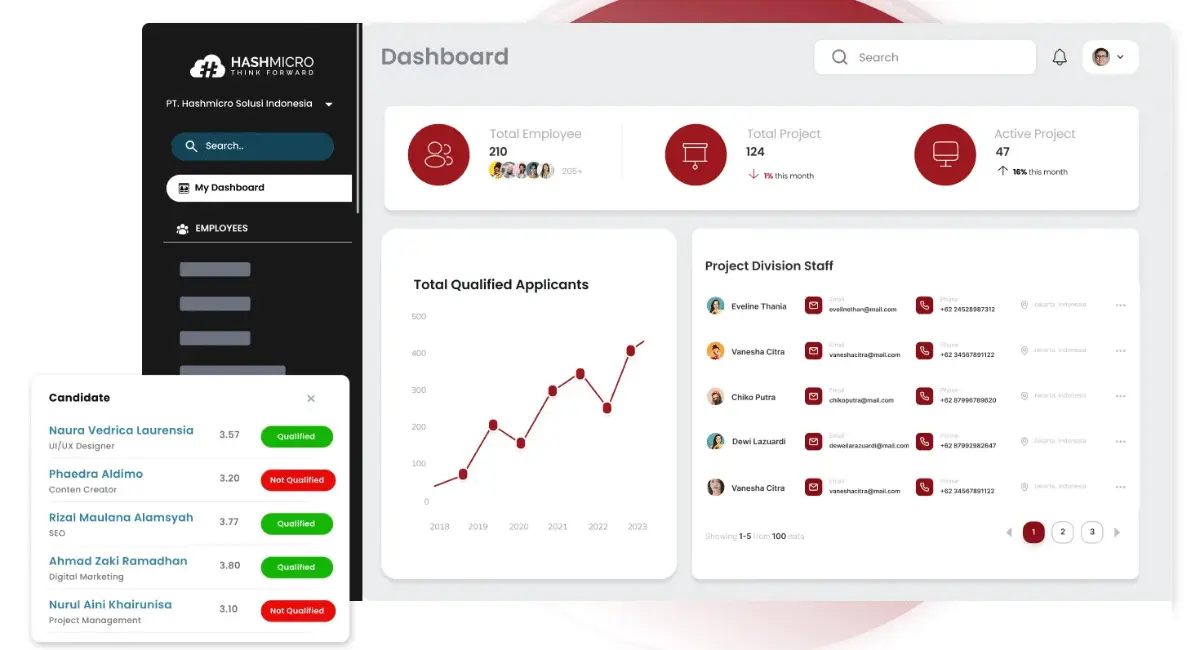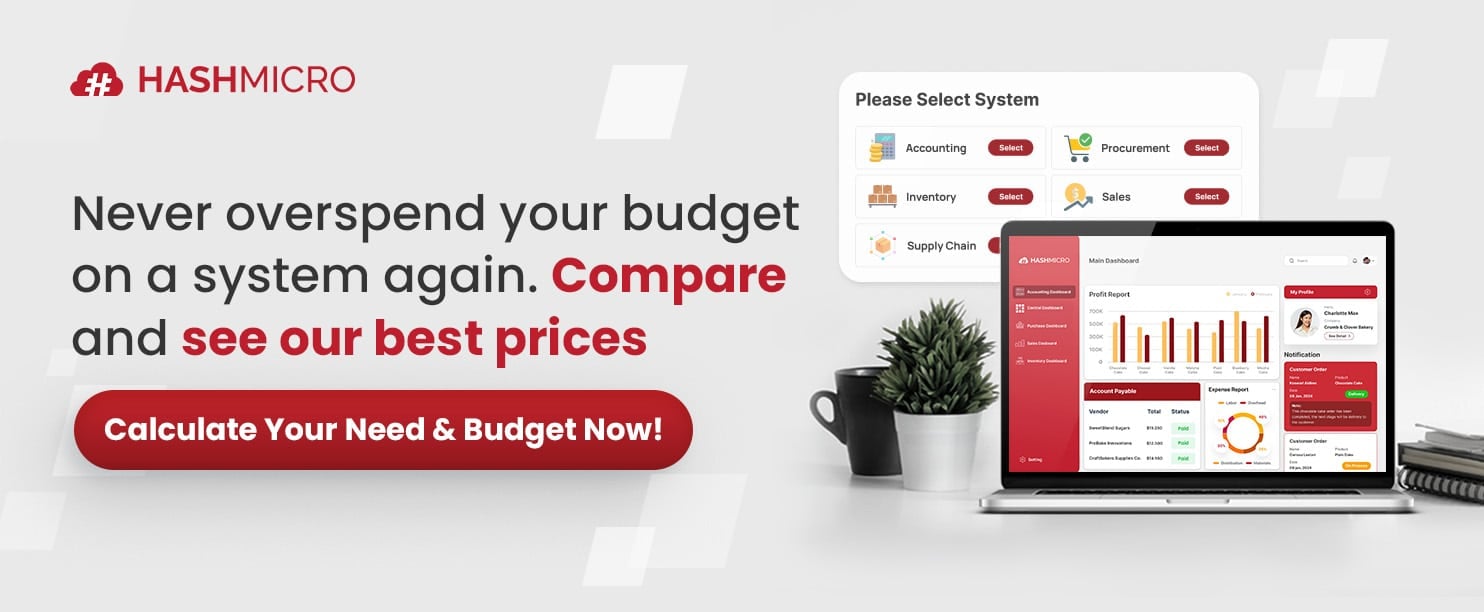Beginning a new job is an exciting milestone filled with new opportunities and responsibilities. However, it also requires handling essential paperwork, such as signing an employment contract. This document serves as the backbone of your professional relationship with your employer.
Unfortunately, many employees neglect to review its details carefully, leading to misunderstandings about their rights and obligations. To prevent that, managing employment contracts can be simple with the right tools. HashMicro’s HRM software automates job contract creation and tracking, ensuring accuracy and compliance at every stage.
With customizable templates, you can save time and minimize errors, while integrated tools streamline HR tasks like payroll and attendance tracking. HashMicro’s all-in-one solution keeps businesses organized, compliant, and efficient.
This article covers the key elements, types, and examples of employment contracts to enhance your understanding of workforce management. Discover how solutions like HashMicro simplify your contract management.
Table of Content
Content Lists

Key Takeaways
|
What is a Contract of Employment?
Employment contracts are official agreements that outline job terms, employee roles, and responsibilities, ensuring clarity for both parties. These contracts specify essential details such as job duration, compensation, benefits, and termination conditions. By setting clear expectations, employment contracts help establish a professional and legally binding framework for the working relationship.
A well-crafted employment contract promotes transparency and security, reducing misunderstandings and potential disputes between employers and employees. Businesses rely on these agreements to define obligations while protecting sensitive company information.
In some cases, an employment contract may also include a “Non-Compete Agreement,” restricting former employees from working for direct competitors within a specified period after leaving the company. This provision helps safeguard the organization’s competitive advantage by preventing the misuse of insider knowledge.
10 Things That Must Be Included in an Employment Contract
As your business expands, adding new team members becomes crucial. While industry connections may have helped build your current team, limited hiring experience highlights the need for a solid HR policy. A well-structured employment contract is the first step, ensuring essential protections for your company and new employees.
Incentives boost employee motivation and align personal goals with company objectives. They promote healthy competition and enhance overall productivity. While every employment contract in Malaysia must contain essential clauses, HR development should prioritize these ten key elements.
1. Job information
The “Job Information” section outlines the employee’s position, duties, and responsibilities. It specifies the job title and scope of work, ensuring clarity between both parties and minimizing potential misunderstandings.
Providing precise job details also helps set goals and assess performance, aligning the employee’s efforts with the company’s overall objectives.
2. Compensations and benefits
An employment contract’s compensation and benefits specify an employee’s prorated salary, bonuses, allowances, and other financial incentives. This section clarifies payment details, including the amount, frequency (e.g., monthly or annually), and additional perks such as health insurance, retirement plans, or other benefits.
Clearly outlining compensation and benefits helps manage expectations for both employers and employees, fostering job satisfaction, motivation, and compliance with labor laws.
3. Time off, sick days, and vacation policy
The “Time Off, Sick Days, and Vacation Policy” section in an employment contract outlines an employee’s leave entitlements, including paid time off, sick leave, and vacation days, along with the procedures for requesting leave.
Clearly defining these policies helps ensure mutual understanding between employers and employees regarding absence management, promoting fairness and transparency while supporting a healthy work-life balance.
Additionally, this section safeguards the company by establishing clear guidelines for planned and unexpected absences, reducing disruptions to business operations.
4. Employee classifications
Properly distinguishing between employees and contractors is essential for complying with tax and insurance regulations. Misclassification can result in legal issues, as Uber’s ongoing lawsuits demonstrate.
Recognizing the fundamental differences between these classifications helps ensure accurate workforce categorization, minimizing risks and preventing potential disputes.
5. The schedule and employment period
An employment contract should clearly define whether the position is permanent or temporary and the expected working hours to establish the employer-employee relationship.
It should specify the required work hours and flexible arrangements, such as remote or hybrid options. If the role involves night or weekend shifts, outlining their frequency and scheduling ensures clarity and aligns expectations for both parties.
6. Confidentiality agreement
Protect confidential information, including trade secrets and customer data, by incorporating a confidentiality agreement within the employment contract. Instead of a separate document, integrate it into the contract with a dedicated section for employees to sign, ensuring clarity and digital compliance.
7. A technology privacy policy
A technology privacy policy establishes clear rules for employees regarding appropriate company technology and data use. It safeguards sensitive information while ensuring digital resources are utilized responsibly and securely.
8. Termination terms and conditions of the employment contract
Clearly outline the procedures for ending the employment relationship, specifying the required notice period and whether a written notice from the employer or the employee is mandatory. Additionally, include any conditions related to termination, such as severance pay.
9. Severance or outplacement plan information
Clearly outline the terms and conditions for ending the employment relationship, detailing the required notice period and whether written notice is mandatory from both the employer and the employee. Additionally, specify any circumstances under which immediate termination may occur.
10. Requirements after termination
Specify any post-employment restrictions or obligations in the employment contract. For example, an employee may be restricted from launching a competing business in the same industry or region for a set period or directly engaging with the company’s clients.
To streamline contract drafting, utilize a digital solution like the HashMicro job proposal template. Its automated process and paperless signing make onboarding new hires more efficient and stress-free.
Beyond employee agreements, businesses frequently establish agreements with other companies to solidify partnerships or collaborations. HashMicro’s HRM software simplifies this process by centralizing all contracts securely and offering various efficiency-boosting features.
Types of Employment Contract Letters

Every employment arrangement has advantages and challenges, making it crucial to document agreements in writing. Selecting the right employment structure should align with your company’s operational needs while adhering to industry norms for each role.
Additionally, businesses should assess how different employment types affect financial performance. Below are the most common categories of workers that companies typically employ.
1. Full-time employment contract
A full-time employment contract is among the most widely used work contracts. It generally requires employees to work a set number of hours per week and offers a stable salary and various benefits.
This agreement defines the employee’s position, duties, and employment terms, covering salary, work hours, and benefits like health insurance, paid leave, and retirement plans. Full-time contracts stabilize both parties, establishing clear expectations and fostering long-term commitment.
2. Part-time employment contract
A part-time employment contract applies to employees working fewer hours than full-time staff, with specified weekly or monthly work hours. These roles typically offer limited benefits, such as reduced access to health insurance and paid leave.
Despite fewer benefits, part-time positions provide flexibility, benefiting employers and employees seeking a better work-life balance. They are commonly used in industries where full-time roles are not always practical or required.
3. Casual employment contract
A casual employment contract applies to workers hired as needed without fixed hours or a guaranteed schedule. This arrangement offers flexibility for employers and employees, making it ideal for short-term or unpredictable workloads.
Casual employees often earn higher hourly wages but typically do not receive benefits like paid leave, sick pay, or overtime pay. These contracts are widely used in industries with varying labor demands, such as hospitality, retail, and seasonal work.
4. Fixed-term employment contract
A fixed-term employment contract is set for a defined period, typically aligned with a specific project, seasonal demand, or other temporary needs. It outlines start and end dates, ensuring both parties understand the employment duration.
These contracts are often used in industries with temporary workforce requirements, such as construction or project-based roles. While benefits like paid leave and health coverage may be limited, fixed-term contracts offer employers flexibility in managing short-term staffing without long-term obligations.
5. Independent employment contract
An independent employment contract, a contractor or freelance agreement, is designed for individuals who provide services to a business as self-employed professionals. It specifies the terms under which the contractor will complete tasks or deliverables.
Unlike traditional employment agreements, these contracts define the scope of work, payment terms, and responsibilities without including employee benefits like health insurance or paid leave.
Independent contractors work autonomously and handle their taxes and insurance. This type of contract is widely used in industries requiring specialized expertise or short-term project-based work.
Simplify Your Employment Contract with HashMicro HRM Software

HashMicro’s HRM software offers a comprehensive solution for managing employment contracts, ensuring accuracy, compliance, and efficiency. Integrated with ERP systems, it simplifies contract creation, storage, and monitoring, helping businesses maintain clear and structured employee agreements.
The system streamlines HR processes, covering everything from contract drafting and digital signing to renewal tracking and compliance management. With its advanced features, HashMicro’s HRM software reduces manual errors, improves transparency, and optimizes contract management.
Here are the key features that make it a great choice for your business:
- Employee Database: This database stores detailed employee records, including contract terms, personal details, and job roles, allowing for quick and easy access when needed.
- Employee Contract Management enables the secure creation, management, and storage of employment contracts while ensuring compliance with labor laws. Both employers and employees can conveniently access contract details.
- Employee On/Off-Boarding: Streamlines the hiring and exit processes by ensuring all required documentation aligns with contract terms, making transitions smoother.
- Payroll Management: Accurately calculates salaries, bonuses, and deductions based on employment contract terms, ensuring precise and compliant payroll processing with payroll software.
In addition to streamlining HR processes, HashMicro introduces Hashy, an AI-powered system designed to automate and optimize contract handling. With Hashy AI, businesses can efficiently manage employment contracts and reduce administrative workload.
The View Leaves Balances feature allows employees to track their remaining leave entitlements, ensuring clarity on their time-off allowances as stated in their employment contracts. Meanwhile, the Questions on SOP feature provides instant access to help employees understand contract-related guidelines and workplace regulations.
For managers, the Generate Leaves Reports feature offers insights into employee leave trends, ensuring compliance with contract terms and maintaining a balanced workload. Meanwhile, Hashy AI‘s Generate Attendance Reports feature helps managers monitor work hours and attendance patterns, aligning with contractual obligations and workforce planning.
Conclusion
This article explores employment contract definitions, types, and examples, highlighting their importance for employers and employees. Understanding these agreements is essential to prevent potential legal and operational risks.
HashMicro’s HRM software simplifies and automates HR and employee management processes, offering Malaysia’s most advanced HR system. The system ensures seamless operations from salary calculations and leave management to attendance tracking and reimbursement handling.
With real-time notifications, your company can stay ahead of contract renewals, preventing expiration issues. The employee contract management feature makes it easy to update agreements on time. Don’t miss out—schedule a free demo of HashMicro today!
Frequently Asked Questions
-
What happens if either party breaches the employment contract?
Suppose an employer or employee fails to uphold the terms of the contract. In that case, the affected party may seek legal remedies, such as compensation or contract termination, depending on the situation and applicable laws.
-
How long is an employment contract valid?
The validity of an employment contract depends on the type (e.g., fixed-term, permanent) and the specific terms agreed upon by both parties.
-
How can I ensure my employment contracts are compliant and efficient?
Using digital tools such as contract management software can help ensure accuracy, compliance with labor laws, and efficient contract handling.
































